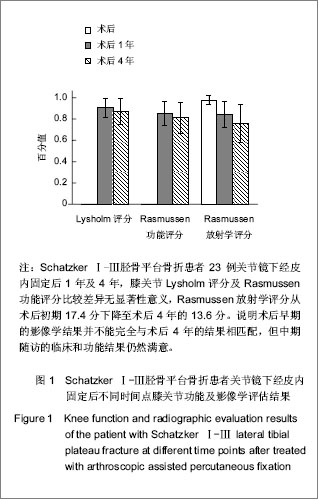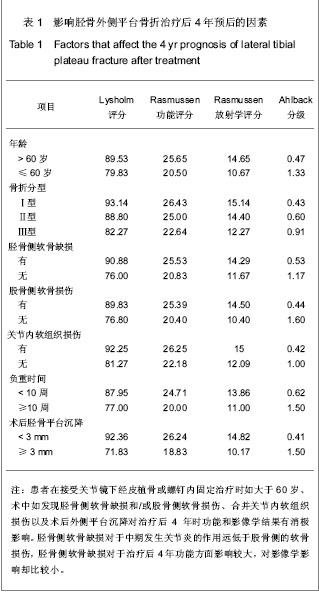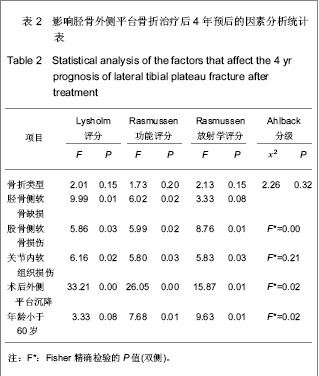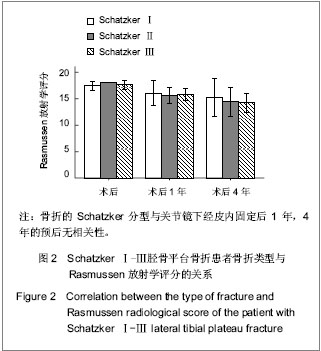| [1] Caspari RB, Hutton PM, Whipple TL, et al. The role of arthroscopy in the management of tibial plateau fractures. Arthroscopy.1985;1(3):76-82.[2] Jennings JE. Arthroscopic management of tibial plateau fractures. Arthroscopy 1985, 1 (3):160-168.[3] Lubowitz JH, Elson WS, Guttmann D.Part I: Arthroscopic management of tibial plateau fractures.Arthroscopy. 2004; 20(10):1063-1070.[4] Dall'oca C, Maluta T, Lavini F, et al. Tibial plateau fractures: compared outcomes between ARIF and ORIF. Strategies Trauma Limb Reconstr. 2012; 7(3):163-175.[5] Zeman P, Zeman J, Matejka J,et al.Long-term results of calcaneal fracture treatment by open reduction and internal fixation using a calcaneal locking compression plate from an extended lateral approach.Acta Chir Orthop Traumatol Cech. 2008;75(6):457-464.[6] Hannouche D, Duparc F, Beaufils P.The arterial vascularization of the lateral tibial condyle: anatomy and surgical applications.Surg Radiol Anat. 2006;28(1):38-45.[7] Hamel A, Ploteau S, Lancien M,et al.Arterial supply to the tibial tuberosity: involvement in patellar ligament transfer in children.Surg Radiol Anat. 2012;34(4):311-316.[8] Pang J, Shen S, Pan WR,et al.The arterial supply of the patellar tendon: anatomical study with clinical implications for knee surgery.Clin Anat. 2009;22(3):371-376.[9] Chan YS, Chiu CH, Lo YP, et al. Arthroscopy-assisted surgery for tibial plateau fractures: 2- to 10-year follow-up results. Arthroscopy.2008;24(7):760-768.[10] Chan YS, Yuan LJ, Hung SS,et al.Arthroscopic-assisted reduction with bilateral buttress plate fixation of complex tibial plateau fractures.Arthroscopy. 2003;19(9):974-984.[11] Asik M, Cetik O, Talu U, et al. Arthroscopy-assisted operative management of tibial plateau fractures. Knee Surg Sports Traumatol Arthrosc.2002;10(6):364-370.[12] Chan YS.Arthroscopy- assisted surgery for tibial plateau fractures.Chang Gung Med J. 2011;34(3):239-247.[13] Honkonen SE.Degenerative arthritis after tibial plateau fractures.J Orthop Trauma. 1995;9(4):273-277.[14] Abdel-Hamid MZ, Chang CH, Chan YS,et al.Arthroscopic evaluation of soft tissue injuries in tibial plateau fractures: retrospective analysis of 98 cases.Arthroscopy. 2006; 22(6): 669-675.[15] Mehin R, O'Brien P, Broekhuyse H, et al. Endstage arthritis following tibia plateau fractures: average 10-year follow-up. Can J Surg.2012;55(2):87-94.[16] Wang BJ,Gao H,Li YD.Zhonghua Guke Zazhi. 2009;8(29): 754-759.王宝军,高化,李亚东.胫骨平台骨折手术治疗的中远期疗效分析[J].中华骨科杂志, 2009, 8(29): 754-759.[17] Gao H.Shoudu Yike Daxue.2007.高化.43例胫骨平台骨折手术治疗的中远期效果分析[D].首都医科大学.2007.[18] Schatzker J, McBroom R, Bruce D. The tibial plateau fracture: the Toronto experience 1968-1975. Clin Orthop Relat Res 1979;(138):94-104.[19] Cassard X, Beaufils P, Blin JL,et al.Osteosynthesis under arthroscopic control of separated tibial plateau fractures. 26 case reports.Rev Chir Orthop Reparatrice Appar Mot. 1999; 85(3):257-266.[20] Zhou Z.Arthroscopic percutaneous osteosynthesis of low-energy tibial plateau fractures.Zhongguo Xiu Fu Chong Jian Wai Ke Za Zhi. 2009;23(11):1316-1318.[21] Hutson JJ Jr, Zych GA.Treatment of comminuted intraarticular distal femur fractures with limited internal and external tensioned wire fixation.J Orthop Trauma. 2000;14(6):405-413.[22] Siegler J, Galissier B, Marcheix PS, et al. Percutaneous fixation of tibial plateau fractures under arthroscopy: a medium term perspective. Orthop Traumatol Surg Res. 2011; 97(1):44-50.[23] Lysholm J, Gillquist J. Evaluation of knee ligament surgery results with special emphasis on use of a scoring scale. Am J Sports Med, 1982, 10(3):150-154.[24] Rasmussen PS. Tibial condylar fractures. Impairment of knee joint stability as an indication for surgical treatment. J Bone Joint Surg Am.1973;55(7):1331-1350.[25] Ahlbäck S.Osteoarthrosis of the knee. A radiographic investigation.Acta Radiol Diagn (Stockh). 1968:Suppl 277: 7-72.[26] Weinlein J, Schmidt A. Acute compartment syndrome in tibial plateau fractures--beware! J Knee Surg. 2010;23(1):9-16.[27] Hak DJ, Lee M, Gotham DR.Influence of prior fasciotomy on infection after open reduction and internal fixation of tibial plateau fractures.J Trauma. 2010;69(4):886-888.[28] Crist BD, Della Rocca GJ, Stannard JP.Compartment syndrome surgical management techniques associated with tibial plateau fractures.J Knee Surg. 2010;23(1):3-7.[29] Ong JC, Kennedy MT, Mitra A, et al. Fixation of tibial plateau fractures with synthetic bone graft versus natural bone graft: a comparison study. Ir J Med Sci.2012; 181(2):247-252.[30] Welch RD, Zhang H, Bronson DG.Experimental tibial plateau fractures augmented with calcium phosphate cement or autologous bone graft.J Bone Joint Surg Am. 2003;85-A(2): 222-231.[31] Russell TA, Leighton RK; Alpha-BSM Tibial Plateau Fracture Study Group.Comparison of autogenous bone graft and endothermic calcium phosphate cement for defect augmentation in tibial plateau fractures. A multicenter, prospective, randomized study.J Bone Joint Surg Am. 2008; 90(10):2057-2061. [32] Wieser K, Betz M, Farshad M, et al. Experimental loss of menisci, cartilage and subchondral bone gradually increases anteroposterior knee laxity. Knee Surg Sports Traumatol Arthrosc. 2012; 20(10):2104-2108. |




.jpg)
.jpg)
.jpg)
.jpg)